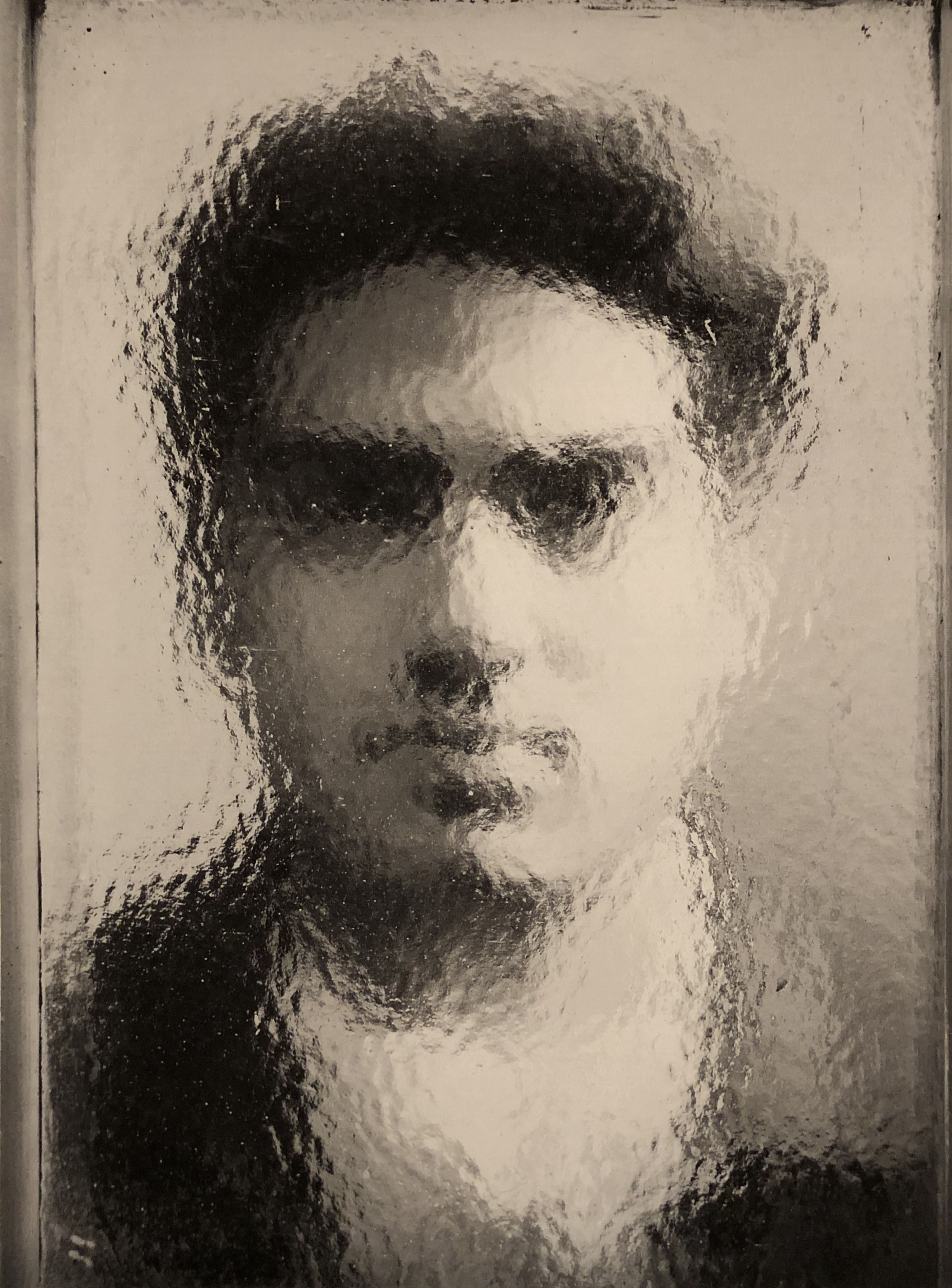"Becoming Van Leo"
 |
| Van Leo, self-portrait, negative 1940s, 2023 print. Rare Books and Special Collections Library at The American University in Cairo |
"Van Leo" is the invented name of Turkey-born, Armenian-Egyptian glamor photographer Levon Boyadjian (1921–2002). As a youth he collected classic B&W Hollywood portraits and reverse-engineered their techniques for the Middle Eastern market. Van Leo thus became part of la dolce vita of Cairo during the golden age of Egyptian cinema (1940s through 1960s). He took pictures of Egyptian movie stars such as Omar Sharif while making his less celebrated clientele look like movie stars. Interest in Van Leo rests largely on a personal project, however. In the 1940s Van Leo would shut down his studio several hours a day to take photos of himself in costume. He became a man of a thousand faces: sheik, bum, cowboy, Jesus, the Wolfman, etc. A small but notable group were in drag. Like a method actor, Van Leo was willing to grow a beard, shave his head, gain weight, whatever—not for a movie but for a photographic negative that might never be printed.
Van Leo is now receiving his first museum show at the Hammer in "Becoming Van Leo." Independent curator Negar Azimi, who met the artist the year before his death, organized the exhibition (thorough Nov. 5, 2023). It's a revelation, not the least for a large sample of self-portraits that Van Leo created and never displayed or even printed.
 |
| Van Leo, self portrait, 1940s |
"My father used to get angry," Van Leo recalled in a 1998 interview. "He'd tell me: 'Did you make the studio for yourself or the customer? Stop making photos of yourself!'"
From today's vantage point, these self-portraits offer parallels to Claude Cahun's work of the 1920s. Van Leo called himself "the Man Ray of Egypt," implying awareness of the American artist's experimental portraits and Rrose Sélavy.
 |
| Van Leo, self portrait, 1942 |
 |
| Installation view of 1940s self portraits |
The cross-gender portraits have led to speculations about Van Leo's sexuality. He was strikingly handsome and had starlet "girlfriends" spanning continents. The relationships never led to marriage. Ragaa Serag, a Miss Egypt-turned-actor, worked for Van Leo's studio as model, receptionist, and even darkroom printer. She was rumored to be a romantic partner. But Serag said: "sex was not part of his life. He was more the romantic type… always thinking about beauty."
 |
| Van Leo, Teddy Lane: South African dancer, 1944. Arab Image Foundation, Beirut |
During the war years Van Leo portrayed the gamut of entertainers who came to Cairo—clowns to strippers. He considered this portrait of South African dancer Teddy Lane to be his masterpiece. He used Vaseline on the sitter's face to create the odd luminance.
Van Leo expected to be world-famous one day. A role model was Yousef Karsh, a fellow Armenian who had survived the genocide, moved to Canada, and became so renowned as to draw sitters from both sides of the Atlantic to his Ottawa studio. Van Leo felt he was not sufficiently appreciated in Cairo and thought of moving to L.A.—or San Francisco, Paris, or South Africa. At age 30, he applied to L.A.'s Art Center College of Design. He was accepted; didn't go. He applied again many years later, and backed out again.
After Tyrone Power's death (1958), an Egyptian tabloid piece proposed that Van Leo was a dead ringer for the actor and could finish his uncompleted film. The article was apparently planted by Van Leo himself.
 |
| Van Leo, Shérihan. Actress. Photo before she was on screen., 1976. Arab Image Foundation, Beirut |
Van Leo had to adopt color but never liked it. He preferred being able to manipulate B&W in his darkroom. The cowgirl is Shérihan, later a famous Egyptian actor.
Van Leo came close to getting a U.S. exhibition curated by publisher Walter Keller (who had done books on Robert Frank, Nan Golden, and Richard Prince). But Van Leo was so impossible to work with that Keller bailed out.
Meanwhile Van Leo was preserving every scrap of personal memorabilia for a future Van Leo museum. In 1998 he donated 13,000 photographs, 16,000 negatives, and countless documents to the American University in Cairo. This institution now owns virtually all of Van Leo's oeuvre.
 |
| Two trophies and a 1938 (self?) portrait of Van Leo with the trophies |
The exhibition ends with a late video in which the beautiful boy is an angry old man. He rants about color photography, street crime, and how Nasser's government swiped his retirement savings.
The best Van Leo Museum so far is the one the Hammer has created for this show. It occupies the works on paper gallery, preserving the cube-within-a-cube configuration used for previous shows. The outside is a timeline of the artist's life and work; the center space is an "analyst's couch, a portal onto the psyche of a complicated, compellingly modern artist."
 |
| Van Leo, self-portrait, 1940s |


Comments
https://collections.lacma.org/node/2245026